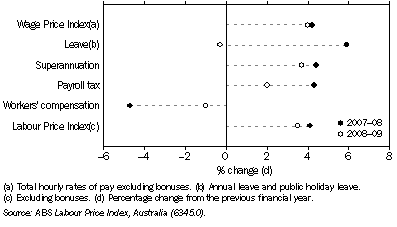LABOUR PRICE INDEX (LPI)
The LPI measures changes in the price of labour services resulting from market forces. The LPI is unaffected by changes in the quality or quantity of work performed, that is, it is unaffected by changes in the composition of the labour force, hours worked, or changes in characteristics of employees (e.g. work performance). The LPI is produced annually on a financial year basis and consists of two components: a wage price index (WPI), published quarterly; and non-wage price index, which is available for each financial year.
WPIs are compiled using information collected from a representative sample of employee jobs within a sample of employing organisations. The ABS constructs four WPIs on a quarterly basis: ordinary time hourly rates of pay excluding bonuses; ordinary time hourly rates of pay including bonuses; total hourly rates of pay excluding bonuses; and total hourly rates of pay including bonuses. Four non-wage indexes are constructed on a financial year basis: annual and public holiday leave; superannuation; payroll tax; and workers' compensation. From these wage and non-wage components, two LPIs are constructed, also on a financial year basis, one including bonuses and one excluding bonuses. Only those indexes which exclude bonuses are pure price indexes because bonuses tend to reflect changes in the quantity and quality of work performed.
Graph 29.11 shows percentage changes from the previous financial year for 2008-09 for several LPI series. The WPI (total hourly rates of pay excluding bonuses) shows a similar rate of change from the previous financial year as it did in 2007-08. All non-wage price indexes, with the exception of Workers' compensation, showed lower rates of change in 2008-09 than in the change from the previous financial year recorded in 2007-08. The Annual Leave and Public Holiday Index showed nearly no movement in 2008-09 compared with the previous financial year due to a reduction in Public Holiday entitlements across a number of states (ANZAC Day was on a weekend in 2009).
29.11 Wage, non-wage and labour price indexes

As shown in table 29.12, increases from the previous financial year for total hourly rates of pay excluding bonuses varied across states and territories. All index numbers have been calculated on a reference base of 2008-09, that is, the numbers in each index series have been set to equal 100.0 for the financial year 2008-09. For Australia, the change from the financial year 2007-08 to 2008-09 was 4.0%. For the states and territories, the highest financial year growth was recorded by Western Australia (5.2%) and the lowest by New South Wales (3.7%).
29.12 TOTAL HOURLY RATES OF PAY EXCLUDING BONUSES, All sectors |
|
 | New South Wales | Victoria | Queensland | South Australia | Western Australia | Tasmania | Northern Territory | Australian Capital Territory | Australia |
INDEX NUMBER(a) |
|
| 2004-05 | 85.9 | 86.1 | 84.4 | 85.2 | 82.2 | 85.0 | 85.0 | 85.3 | 85.2 |
| 2005-06 | 89.4 | 89.4 | 88.1 | 88.4 | 85.8 | 88.5 | 88.7 | 88.8 | 88.7 |
| 2006-07 | 92.8 | 92.6 | 92.1 | 91.9 | 89.9 | 92.4 | 92.1 | 92.4 | 92.3 |
| 2007-08 | 96.4 | 96.2 | 96.0 | 96.2 | 95.1 | 95.9 | 95.7 | 96.3 | 96.2 |
| 2008-09 | 100.0 | 100.0 | 100.0 | 100.0 | 100.0 | 100.0 | 100.0 | 100.0 | 100.0 |
CHANGE FROM CORRESPONDING QUARTER OF PREVIOUS YEAR (%) |
|
| 2004-05 | 3.6 | 3.9 | 3.8 | 3.4 | 4.3 | 4.2 | 3.7 | 4.4 | 3.8 |
| 2005-06 | 4.1 | 3.8 | 4.4 | 3.8 | 4.4 | 4.1 | 4.4 | 4.1 | 4.1 |
| 2006-07 | 3.8 | 3.6 | 4.5 | 4.0 | 4.8 | 4.4 | 3.8 | 4.1 | 4.1 |
| 2007-08 | 3.9 | 3.9 | 4.2 | 4.7 | 5.8 | 3.8 | 3.9 | 4.2 | 4.2 |
| 2008-09 | 3.7 | 4.0 | 4.2 | 4.0 | 5.2 | 4.3 | 4.5 | 3.8 | 4.0 |
|
| (a) Base of each index: Financial year 2008-09 = 100.0. |
| Source: ABS Labour Price Index, Australia (6345.0). |
Financial year increases in the total hourly rates of pay excluding bonuses, by industry, are shown in graph 29.13, with industry defined in terms of the Australian and New Zealand Standard Industrial Classification (ANZSIC) 2006 edition. Data in previous issues were based on the 1993 version of ANZSIC. Indexes for previous periods have been reproduced on an ANZSIC 2006 basis by reclassifying the businesses that reported data in earlier periods to the appropriate industry division of ANZSIC 2006. Index movements for Australia, state/territory, sector and All industries series were not affected by the introduction of the new industry classification. Changes from financial year 2007-08 to 2008-09 ranged from 3.0% for the Accommodation and food services industries, to 5.6% for the Mining industry.
29.13 TOTAL HOURLY RATES OF PAY EXCLUDING BONUSES, By industry(a)

 Print Page
Print Page